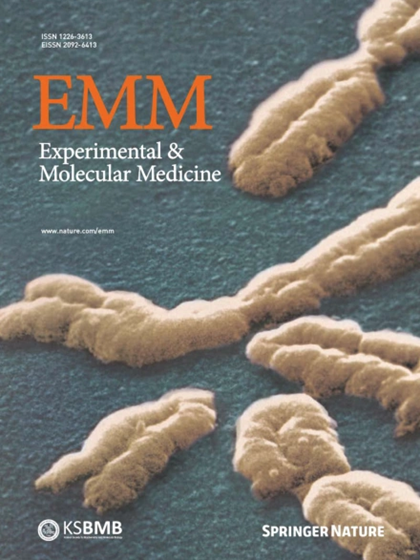LncRNA Gm35585转录激活过氧化物酶EHHADH,防止饮食诱发脂肪肝。
IF 9.5
2区 医学
Q1 BIOCHEMISTRY & MOLECULAR BIOLOGY
引用次数: 0
摘要
代谢功能障碍相关的脂肪变性肝病是世界范围内最常见的慢性肝病之一,迄今尚无批准的治疗方法。在这里,我们报道了Gm35585的肝脏过表达,这是一种在喂食高脂肪饮食的小鼠肝脏中下调的新型lncRNA,在缓解肝脏脂质积累病理方面具有重要的功能。Gm35585激活过氧化物酶体增殖物激活受体α (PPARα)信号通路,促进下游PPARα靶基因、烯酰辅酶a水合酶和3-羟酰基辅酶a脱氢酶(EHHADH)的表达,是过氧化物酶体β-氧化途径的四种酶之一。EHHADH的激活促进了长链脂肪酸(LCFAs)的氧化,肝脏LCFAs水平的升高有助于代谢功能障碍相关的脂肪变性肝病。机制上,Gm35585与类视黄嘌呤X受体α (RXRα)结合,与PPARα形成PPARα/RXRα异源二聚体,并引导异源二聚体识别EHHADH的启动子,称为过氧化物酶体增殖体激活受体应答元件,引起EHHADH的转录激活。综上所述,Gm35585是一种肝脏脂质代谢调节剂,可激活EHHADH转录,促进LCFAs的过氧化物酶体β-氧化,最终改善饮食诱导的脂肪肝。本文章由计算机程序翻译,如有差异,请以英文原文为准。

LncRNA Gm35585 transcriptionally activates the peroxidase EHHADH against diet-induced fatty liver
Metabolic-dysfunction-associated steatotic liver disease is one of the most common chronic liver diseases worldwide and has no approved treatment thus far. Here we report that the hepatic overexpression of Gm35585, a novel lncRNA downregulated in the livers of mice fed a high-fat diet, is functionally important in alleviating hepatic lipid accumulation pathologies. Gm35585 activates the peroxisome proliferator-activated receptor α (PPARα) signaling pathway and promotes the expression of downstream PPARα-target gene, enoyl-CoA hydratase and 3-hydroxyacyl CoA dehydrogenase (EHHADH), which is one of the four enzymes of the peroxisomal β-oxidation pathway. Activation of EHHADH promotes the oxidation of long-chain fatty acids (LCFAs), and the increased levels of hepatic LCFAs contribute to metabolic-dysfunction-associated steatotic liver disease. Mechanistically, Gm35585 binds to retinoid X receptor α (RXRα) and then forms a PPARα/RXRα heterodimer with PPARα and guides the heterodimer to recognize the promoter of EHHADH, which is called peroxisome proliferator-activated receptor response element, causing transcriptional activation of EHHADH. Taken together, Gm35585 is a hepatic lipid metabolism regulator that activates EHHADH transcription, promoting peroxisomal β-oxidation of LCFAs and ultimately ameliorating diet-induced fatty liver. Metabolic-dysfunction-associated steatotic liver disease (MASLD) is a growing global health issue affecting millions and leads to severe liver conditions. Researchers explored new ways to treat MASLD by studying a molecule called Gm35585. In their study, they used mice fed a high-fat diet to mimic human liver disease. They found that Gm35585 helps to break down harmful fats in the liver by activating a protein called EHHADH, which is involved in fat metabolism. This process reduces fat accumulation in the liver, potentially slowing disease progression. They concluded that Gm35585 could be a promising target for developing new MASLD treatments. Their findings suggest that enhancing the activity of EHHADH through Gm35585 might offer a new therapeutic strategy. Future research could focus on how this approach can be applied to human treatments for fatty liver disease. This summary was initially drafted using artificial intelligence, then revised and fact-checked by the author.
求助全文
通过发布文献求助,成功后即可免费获取论文全文。
去求助
来源期刊

Experimental and Molecular Medicine
医学-生化与分子生物学
CiteScore
19.50
自引率
0.80%
发文量
166
审稿时长
3 months
期刊介绍:
Experimental & Molecular Medicine (EMM) stands as Korea's pioneering biochemistry journal, established in 1964 and rejuvenated in 1996 as an Open Access, fully peer-reviewed international journal. Dedicated to advancing translational research and showcasing recent breakthroughs in the biomedical realm, EMM invites submissions encompassing genetic, molecular, and cellular studies of human physiology and diseases. Emphasizing the correlation between experimental and translational research and enhanced clinical benefits, the journal actively encourages contributions employing specific molecular tools. Welcoming studies that bridge basic discoveries with clinical relevance, alongside articles demonstrating clear in vivo significance and novelty, Experimental & Molecular Medicine proudly serves as an open-access, online-only repository of cutting-edge medical research.
 求助内容:
求助内容: 应助结果提醒方式:
应助结果提醒方式:


